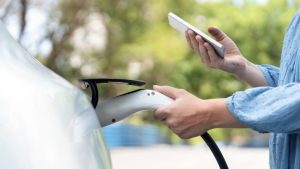 According to research by EY, the motivator for buying electric vehicles is concern for the environment. However, EV users still cannot say whether the energy used to charge their electric vehicles is green energy or produced by coal-fired power stations — until now.
According to research by EY, the motivator for buying electric vehicles is concern for the environment. However, EV users still cannot say whether the energy used to charge their electric vehicles is green energy or produced by coal-fired power stations — until now.
Monta, the vendor behind the leading Electric Vehicle (EV) charging platform and Electricity Maps, have forged a partnership. Monta believes that the combination could enable EV users to reduce their carbon impact by 4.5 times. The caveat is that this could come at an additional cost. But the key to the decision is that the users now have a choice.
Electricity Maps provides actionable electricity data for more than 230 regions, including Europe and the US. The data helps organisations better understand the sources of electricity. Monta has analysed the data collected from its SmartCharge app users over the last 12 months. It has combined it with the Electricity Maps data. It showed that almost 70,000 SmartCharge sessions were optimised for cleaner, greener charging. The carbon saving per charge was an average of 203g of carbon, This was compared to a price-optimised charging session that saved an average of 37g.
Looking forward to the partnership
The analysis provided above is historical. However, now integrated, Monta Users can better determine when prices are cheaper and when sources are greener. Users have historically opted to charge when prices are low, often unaware that such charging has a high carbon footprint.
Monta has integrated into the Electricity Maps platform using a standard API. It uses this to extract data to inform two variables in the SmartCharge algorithm:
- Charging when CO2 is lowest
- Charging when electricity is primarily from renewable sources
The data from Electricity Maps allows Monta to provide accurate information to users so they can be informed when the optimal time for charging, both to keep their carbon footprint and price point lower.

Alok Dubey, Regional Director, Strategic Sales – West at Monta, said, “We entered this partnership to enhance EV charging with a focus on reducing carbon emissions and what we have achieved is to provide users with the freedom to set their SmartCharge preferences based on what is most important to them – CO2 intensity, charging from renewable energy, or price. Our SmartCharge algorithm then uses these settings to determine the optimal, bespoke charging schedule.”
The green want to get greener
As the EY study indicates, many people are still choosing electric vehicles because of the lower emissions compared to combustion engine alternatives. It means that they are already conscious of their carbon footprint. They are often seeking other ways to reduce their footprint.
Within businesses, fleet managers are now able to more accurately identify their fleet’s carbon emissions. They can also instruct fleet users to optimise charging sessions to combine the lowest pricing with the lowest carbon emissions. These decisions can help organisations achieve their carbon reduction targets faster.
Before now, the challenge for many EV and fleet owners was that unless they had access to solar panels, they often charged from the national grid. They had little control over the carbon footprint of the electricity used. Electricity Maps gathers data from utility companies such as EDF.
EV owners who charge directly from the national electricity grid, as opposed to other sources such as solar panels, have very little control over the source of their electricity. This makes it difficult for these users to control and regulate their emissions from charging their EVs.
Monta is now giving its users a choice: the more that opt for cleaner energy, the better it is for the planet and the more efficient the use of the national energy infrastructure. Each lowering the use of non-green energy sources. Importantly, as more solar farms come into use, these habits and charging times are likely to be supported and strengthened. With more energy coming online at those times. Already, Monta has seen an increase of 48% in the number of users charging using the greener option.
Olivier Corradi, CEO and Founder of Electricity Maps, said, “Electricity Maps is proud to partner with Monta to drive a cleaner future for transportation. We’re excited to see that by providing forecasted carbon intensity data to their SmartCharge algorithm, we’re jointly empowering EV drivers to make informed decisions leading to significant reductions in their emissions.”
Enterprise Times: What does this mean
In some ways, it is refreshing to hear of a story that just leverages data for the greater good. Rather than one that relies on AI to create an improvement. However, could AI bring better predictions about what the cleanest and cheapest times to charge are in the future for users? So that they can better plan their day and take even greater advantage of greener energy.
Monta is constantly driving the benefits of its EV charging platform forward. In the interest of customers, both corporate and individual. This announcement is another example of that.
























